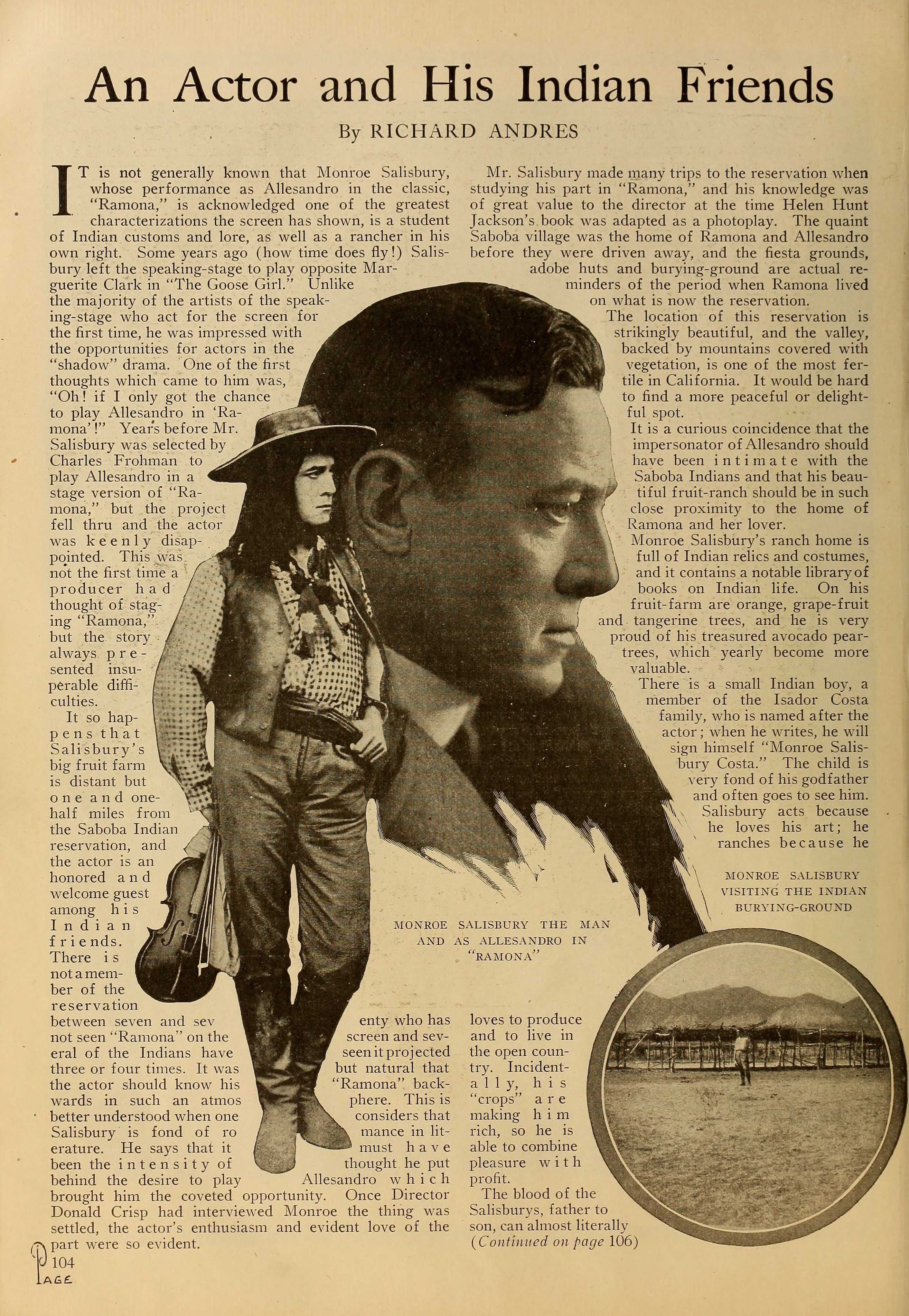Monroe Salisbury — An Actor and His Indian Friends (1918) 🇺🇸

Some years ago (how time does fly!) Salisbury left the speaking-stage to play opposite Marguerite Clark in The Goose Girl. Unlike the majority of the artists of the speaking-stage who act for the screen for the first time, he was impressed with the opportunities for actors in the “shadow” drama.
by Richard Andres
One of the first thoughts which came to him was, “Oh! if I only got the chance to play Alessandro in Ramona!” Year’s before Mr. Salisbury was selected by Charles Frohman to play Alessandro in a stage version of Ramona, but the project fell thru and the actor was keenly disappointed. This was not the first time a producer had thought of staging Ramona, but the story always presented insuperable difficulties.
It so happens that Salisbury’s big fruit farm is distant but one and one-half miles from the Saboba Indian reservation, and the actor is an honored and welcome guest among his Indian friends. There is not a member of the reservation between seven and seventy who has not seen Ramona on the screen and several of the Indians have seen it projected three or four times. It was but natural that the actor should know his Ramona backwards in such an atmosphere. This is better understood when one considers that Salisbury is fond of romance in literature. He says that it must have been the intensity of thought he put behind the desire to play Alessandro which brought him the coveted opportunity. Once Director Donald Crisp had interviewed Monroe the thing was settled, the actor’s enthusiasm and evident love of the part were so evident.
Mr. Salisbury made many trips to the reservation when studying his part in Ramona, and his knowledge was of great value to the director at the time Helen Hunt Jackson’s. book was adapted as a photoplay. The quaint Saboba village was the home of Ramona and Alessandro before they were driven away, and the fiesta grounds, adobe huts and burying-ground are actual reminders of the period when Ramona lived on what is now the reservation.
The location of this reservation is strikingly beautiful, and the valley, backed by mountains covered with vegetation, is one of the most fertile in California. It would be hard to find a more peaceful or delightful spot.
It is a curious coincidence that the impersonator of Alessandro should have been intimate with the Saboba Indians and that his beautiful fruit-ranch should be in such close proximity to the home of Ramona and her lover.
Monroe Salisbury’s ranch home is full of Indian relics and costumes, and it contains a notable library of books on Indian life. On his fruit-farm are orange, grape-fruit and tangerine trees, and he is very proud of his treasured avocado pear-trees, which yearly become more valuable.
There is a small Indian boy, a member of the Isador Costa family, who is named after the actor; when he writes, he will sign himself “Monroe Salisbury Costa.” The child is very fond of his godfather and often goes to see him. Salisbury acts because he loves his art; he ranches because he loves to produce and to live ii the open country. Incidentally, his “crops” are making him rich, so he is able to combine pleasure with profit.
The blood of the Salisburys, father to son, can almost literally be said to course thru horse-flesh. The late Monroe Salisbury was famous as the owner and driver of piston-limbed trotters. His sulky and trotters were a familiar sight on all the Western tracks. Monroe “followed in his father’s hoof-steps” and became a great lover of blooded horses. The day of the big stable string has passed away, but Monroe Salisbury still shows his appreciation for and fondness of the horse by taking the best of care of the mounts in his ranch stable.

Monroe Salisbury visiting the Indian burying-ground

Monroe Salisbury is a six-footer but he looks like Alice in Wonderland among the “weeds” in his garden these giant cacti are fine specimens of their kind, form impassable barriers across the plains, and live to a venerable old age
The Indian graveyard in the village immortalized by Ramona
Monroe Salisbury in front of an old Indian adobe house built by the Sabobas
—
Bill Hart’s First Interpretation of An Indian (1918)
by Marjorie Gleyre Lachmund
A friend of mine, who was a neighbor of William S. Hart and knew him in the days before his rise to screen fame, tells this amusing incident: “It was about four years ago, before Bill Hart entered the picture field — before he even dreamed of the renown and popularity which were to be his. He was, and is, a modest, unaffected fellow; and whatever ‘posing’ he does is thrust upon him by his present position in the limelight. The scene of this incident is laid in Westport, Connecticut, which is his home-town and mine.
”On a very hot summer day I was going down to the beach to see if I could possibly cool off. As I passed the house of my artist friend, Norbert Marchand, I thought I would stop and ask him to go along. He was not in the house, so I went over to the old shack which he had fitted up for a studio. Looking over the half-door, I beheld Marchand painting away for dear life, while in front of him Hart was posing as an Indian. Sitting astride a saw-horse, which was equipped with saddle and bridle, he was gazing at the opposite wall with the lofty expression of noble hauteur befitting an Indian warrior, while drop after drop of perspiration coursed down his cheeks. It was a sight for the gods!”
Collection: Motion Picture Magazine, March 1918
